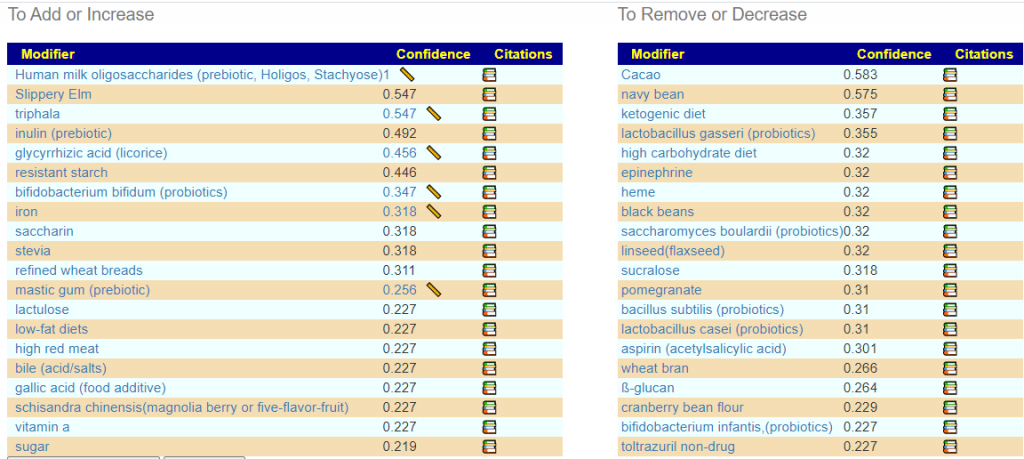Description: boy is almost 6, has big belly, low muscle tone, sensitivity issues, ADHD and very functional ASD.
Analysis
Using US National Library of Medicine (PubMed)
Since we have two defined conditions specified, I apply PubMed literature to the sample. This information is not predictive because there are many subgroup for both conditions. The information gives us more probable candidates of the bacteria involved.
Ordering them by highest percentile, we see Generalized anxiety disorder at 76%ile which is a likely match for sensitive issues. Two other high matches of interest are:
- Irritable Bowel Syndrome 75%ile
- Brain Trauma 72%ile (which is reasonable for autism)
I also checked Naive Predicted Symptoms From Citizen Science 2.0 and there was no additional really significant matches (Comorbid: Panic Attacks, Immune: Sensitivity to smell/food/medication/chemicals ) with the possible exception of Condition: Non-Celiac Gluten Sensitivity. This last one is fuzzy because a child’s microbiome is very different from an adult (and most of our data is adult), however doing a gluten free trial for 2 weeks is an easy way to test this. If issues improved, then keep gluten free for 6 months and then retest the microbiome.
Outliers (abnormal values)
Going to My Biome View(Taxon Hierarchy View) spotted some items of concern:
- Burkholderiales is 10% of the microbiome, almost one of the highest values seen.
- Could not find any studies of this with autism or ADHD, but looking at its components
- Alcaligenaceae
- “we demonstrate that increased levels of Alcaligenaceae in intestinal biopsy samples from AUT-GI children result from the presence of high levels of members of the genus Sutterella.” [2012]
- ” children with ASD still had unique bacterial biomarkers, such as Alcaligenaceae, Enterobacteriaceae, and Clostridium” [2019]
- Sutterellaceae (see above)
- “almost all the identified Sutterellaceae and Enterobacteriaceae were the highest in AD.” [2013]
- Prevotella copri is 6%
- Associated to both autism and obesity [2021]
- Prevotellaceae is almost exclusively this strain.
- Blautia coccoides is 6%
As this is a child (and most of the data on Microbiome Prescription is for adults), I consulted A Systematic Review of the Microbiome in Children With Neurodevelopmental Disorders [2019] where I read “Prevotellaceae, Lactobacillaceae, and Mogibacteraceae resulted as being the 3 key families discriminating samples from children with ASD from samples from HCs. “, so let us check the other two in our sample:
- Lactobacillaceae is low (agrees with the above study)
- Mogibacteraceae is not reported on any of the common 16s tests.
Where do we go from here?
I am going to get suggestions in several different ways:
- Hand pick: Lactobacillaceae, Alcaligenaceae, Sutterellaceae and Prevotella copri (which is almost all of the Prevotellaceae) – Note: all of these are “Family” level and below.
- Kaltoft-Moltrup unfiltered
- Kaltoft-Moltrup filtered by Autism (PubMed studies)
The goal is to identify items common across all of them. There is no definitive best approach. The first one is very focused on specific bacteria that is both associated with autism and abnormal in the sample. The others are more generic approach which include more bacteria families.



We have the commonality shown below (i.e. items are on all three approaches). remember there is no definitive best approach. I have done the three that I am most inclined to and then we intersect the results to get a consensus from the approaches.
- To Add
- Triphala – one of my favorite ayurvedic herbs, we make our own capsules
- Slippery Elm
- glycyrrhizic acid (licorice). For a 6 year old, this can be a problem — I was introduced to pure licorice candies when I was about 5 by my grandmother. Today I use Spezzata on occasion, this is pure licorice with no sugar added.
- bifidobacterium bifidum (probiotics)
- mastic gum (prebiotic)
- To Avoid
- navy bean
- black beans
- wheat bran
- Cacao (sorry kid, no chocolate bars!)
- ketogenic diet
- saccharomyces boulardii (probiotics)
- epinephrine
- heme
Bottom Line
This child microbiome fits the general pattern for autism in children according to the literature. It is my belief that issues will improve with microbiome manipulation. Yesterday, I has a long conversation with someone in Europe that consults on Autistic children using their microbiome and Microbiome Prescription. He reports consistent improvement with his clients.
Usual advice: Please review with your medical professional before making any changes. The suggestions come from a mathematical model and not clinical experience. The suggestions above applies to this person with their unique microbiome. Get a microbiome done and follow the pattern of analysis above to get what is appropriate to your child.